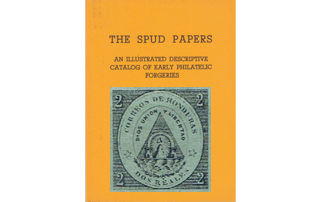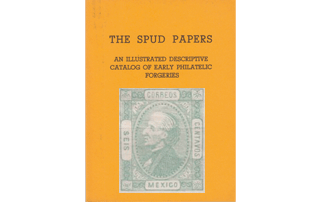Spud Papers – Honduras
 1866. 2 Reales, Green, Rose.
1866. 2 Reales, Green, Rose.
These stamps come first, both alphabetically and in the order of merit. The forgers, having only lithographs to imitate, have succeeded in producing some very passable counterfeits, well-calculated to deceive too-confiding youth. I confess to having experienced some little difficulty in finding any sufficiently well-marked and salient points of difference between the forgeries and the originals.
Genuine
Lithographed, in greyish black, on bluish-green, or orange-pink paper. The outer oval touches the outline of the frame at top and bottom. The transverse lines of shading in the pyramid (or cone, or triangle, or whatever it is), do not trespass beyond the outline on either side. The semicircle connecting the two towers is composed of three lines, two outlines and a fine central line. The thick outline of the oval is tolerably smooth all the way round. There is no boundary-line at the sides of the stamps, and the top and bottom lines are very little thicker than the rest. The doors leading into the towers are not more than twice the size of the windows. The crossed branches are rather smudged and indistinct. All the used copies which I have seen, are obliterated with a large pen-and-ink cross.
Forged
Lithographed in black, on yellowish-green or bluish-pink paper. There is a considerable space between the central oval and the boundary-line, both at top and bottom. The transverse lines of shading show beyond the outline of the pyramid, especially on the left side. The semicircle connecting the towers is composed of two lines only. The thick outline of the oval is very wavy below the words DOS REALES. There is a fine boundary-line at the sides of the stamps, and a thick one at the top, much thicker than the rest. The windows in the towers are only about one-fourth the size of the doors. The crossed branches are much clearer and more distinct than in the originals. Instead of contenting themselves with pen-marking the counterfeits, the forgers have actually lithographed the pen-and-ink obliteration found on the originals!
Although, at first sight, these forgeries have a very deceptive look, yet, I think that the tests given above, will be amply sufficient to enable anyone to decide at once between the genuine stamps and their counterfeits. Moens says that the green stamps are for home use, and the pink for foreign postage; but, for my own part, I don’t believe the officials are very particular in this respect. And besides this, I fancy that, in any case, neither the green nor the pink stamps would frank a letter beyond the boundary of the Republic, certainly not to England, as we have no postal convention with these small American States.
From “The Spud Papers” by Atless, Pemberton & Earée, 1871-1881.












Leave a Reply
Want to join the discussion?Feel free to contribute!